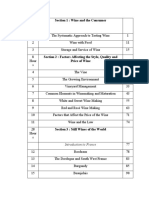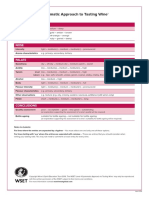80%(10)80% found this document useful (10 votes)
1K viewsWSET L3 Wine Lexicon
WSET L3 Wine Lexicon
Uploaded by
JCRThe document lists various primary, secondary, and tertiary aromas that can be detected in wine. In the primary aromas section, it lists various floral, fruit, and herbaceous aromas. The secondary aromas section lists yeast, malolactic conversion, and oak influences. The tertiary aromas section describes aromas from deliberate oxidation and fruit and bottle development, including nuts, chocolate, coffee, and petroleum/toast aromas developing with age.
Copyright:
© All Rights Reserved
Available Formats
Download as PPTX, PDF, TXT or read online from Scribd
WSET L3 Wine Lexicon
WSET L3 Wine Lexicon
Uploaded by
JCR80%(10)80% found this document useful (10 votes)
1K views23 pagesThe document lists various primary, secondary, and tertiary aromas that can be detected in wine. In the primary aromas section, it lists various floral, fruit, and herbaceous aromas. The secondary aromas section lists yeast, malolactic conversion, and oak influences. The tertiary aromas section describes aromas from deliberate oxidation and fruit and bottle development, including nuts, chocolate, coffee, and petroleum/toast aromas developing with age.
Original Description:
Study guide for wine descriptors used in WSET Level 3
Copyright
© © All Rights Reserved
Available Formats
PPTX, PDF, TXT or read online from Scribd
Share this document
Did you find this document useful?
Is this content inappropriate?
The document lists various primary, secondary, and tertiary aromas that can be detected in wine. In the primary aromas section, it lists various floral, fruit, and herbaceous aromas. The secondary aromas section lists yeast, malolactic conversion, and oak influences. The tertiary aromas section describes aromas from deliberate oxidation and fruit and bottle development, including nuts, chocolate, coffee, and petroleum/toast aromas developing with age.
Copyright:
© All Rights Reserved
Available Formats
Download as PPTX, PDF, TXT or read online from Scribd
Download as pptx, pdf, or txt
80%(10)80% found this document useful (10 votes)
1K views23 pagesWSET L3 Wine Lexicon
WSET L3 Wine Lexicon
Uploaded by
JCRThe document lists various primary, secondary, and tertiary aromas that can be detected in wine. In the primary aromas section, it lists various floral, fruit, and herbaceous aromas. The secondary aromas section lists yeast, malolactic conversion, and oak influences. The tertiary aromas section describes aromas from deliberate oxidation and fruit and bottle development, including nuts, chocolate, coffee, and petroleum/toast aromas developing with age.
Copyright:
© All Rights Reserved
Available Formats
Download as PPTX, PDF, TXT or read online from Scribd
Download as pptx, pdf, or txt
You are on page 1of 23
Primary Aromas
Floral
Rose Violet Chamomile Geranium
Acacia Blossom Elderflower Honeysuckle
Green Fruit
Apple Pear Grape
Gooseberry Quince Pear Drop
Citrus Fruit
Grapefruit Lemon Lime (juice, zest)
Orange Peel Lemon Peel
Stone Fruit
Peach Apricot Nectarine
Tropical Fruit
Banana Lychee Mango
Passion Fruit Pineapple Melon
Red Fruit
Cranberry Raspberry Strawberry
Redcurrant Red Cherry Red Plum
Black Fruit
Blackberry Blueberry Black Cherry
Blackcurrant Black Plum
Bramble
Dried / Cooked Fruit
Fig Prune Raisin Sultana
Kirsch
Jamminess Baked / Stewed Fruit Preserved Fruit
Herbaceous
Green Bell Pepper Grass Tomato Leaf
Asparragus Blackcurrant Leaf
Herbal
Eucalyptus Mint Lavender
Fennel Dilll Medicinal
Pungent Spice
Black Pepper White Pepper Liquorice
Other Primary Aromas
Flint Wet Stones Wet Wool
Secondary Aromas
Yeast
Biscuit Bread Toast Pastry
Brioche Bread Dough Cheese
Malolactic Conversion
Butter Cream Cheese
Oak
Vanilla Cloves Nutmeg Coconut Chocolate Coffee
Butterscotch Toast Cedar Charred Wood Smoke Resinuous
Tertiary Aromas
Deliberate Oxidation
Almond Marzipan Hazelnut Walnut
Chocolate Coffee Toffee Caramel
Fruit Development (White)
Dried Apricots Dried Apples Dried Banana Marmelade
Fruit Development (Red)
Fig Prune Dried Blackberry Dried Cranberry
Cooked Blackberry Cooked Red Plum Tar
Bottle Age (White)
Petrol Kerosene Hay Toast Honey
Ginger Cinnamon Nutmeg Mushroom Nutty
Bottle Age (Red)
Leather Forest Floor Earth Mushroom Game
Tobacco Wet Leaves Meaty Savoury Farmyard
You might also like
- Fine Vintage Level 3 Practice Questions 2017Document52 pagesFine Vintage Level 3 Practice Questions 2017Tu Duy Nguyen Ba100% (19)
- D1: Wine Production: WSET® Level 4 DiplomaDocument232 pagesD1: Wine Production: WSET® Level 4 DiplomaJoyce Yeung100% (16)
- WSET Level 3 Study Notes Flashcards - QuizletDocument15 pagesWSET Level 3 Study Notes Flashcards - QuizletMichael Tselepis100% (19)
- WSET 3 - ContentsDocument5 pagesWSET 3 - ContentsL50% (4)
- D4 Sparkling Wines - An Accompaniment To The WSET Level 4 Diploma in Wines by Wine Spirit Education TrustDocument122 pagesD4 Sparkling Wines - An Accompaniment To The WSET Level 4 Diploma in Wines by Wine Spirit Education TrustMatt Hunt88% (17)
- Brain Scape WSET+Level+3+Practice+Exam+QuestionsDocument11 pagesBrain Scape WSET+Level+3+Practice+Exam+QuestionsCaitlin100% (10)
- WSET Level 3 Systematic Approach To Tasting WineDocument2 pagesWSET Level 3 Systematic Approach To Tasting WineDallas Bergen85% (13)
- Wset Level 2Document63 pagesWset Level 2Jason-chung33% (3)
- The WSET® Level 2 Certificate in Wines and Spirits 2010-06Document32 pagesThe WSET® Level 2 Certificate in Wines and Spirits 2010-06litium_ballance100% (11)
- WSET Diploma Wines of The World Past Questions by Topic (2004-2022) CompilationDocument50 pagesWSET Diploma Wines of The World Past Questions by Topic (2004-2022) Compilationallen19821205100% (2)
- D5 Fortified Wines - An Accompaniment To The WSET Level 4 Diploma in Wines by Wine Spirit Education TrustDocument74 pagesD5 Fortified Wines - An Accompaniment To The WSET Level 4 Diploma in Wines by Wine Spirit Education TrustMatt HuntNo ratings yet
- 更新的红酒培训WSET Level 2 中级教材Looking Behind the LabelsDocument83 pages更新的红酒培训WSET Level 2 中级教材Looking Behind the Labels凱日本100% (1)
- 1 CMS Introductory Workbook 2019 - 89 (001-050)Document50 pages1 CMS Introductory Workbook 2019 - 89 (001-050)Jose Benito Morales Garcia100% (4)
- WSET L2 Practice Review QuestionsDocument58 pagesWSET L2 Practice Review Questionsdonhankiet100% (11)
- WSET - L3 Spirits - Study GuideDocument36 pagesWSET - L3 Spirits - Study GuideMVSA餐飲部0% (1)
- WSET4 Grape Varieties - Mindmaps - v2023 03 05Document110 pagesWSET4 Grape Varieties - Mindmaps - v2023 03 05Mika Cantabile100% (5)
- WSET L4Wines D2 Wine Business en LowRes Aug2023Document117 pagesWSET L4Wines D2 Wine Business en LowRes Aug2023Cecilia Chansiin100% (2)
- Wset Level 3 Mock QuestionsDocument6 pagesWset Level 3 Mock QuestionsSnehal Deshmukh0% (1)
- WSET 2 Spirits Study GuideDocument26 pagesWSET 2 Spirits Study GuideFloris50% (4)
- Brainscape WSET Practice Exam AnswersDocument8 pagesBrainscape WSET Practice Exam AnswersCaitlin100% (2)
- WSET Level 3Wine-Lexicon: Supporting The WSET Level 3systematic Approach To Tasting Wine®Document2 pagesWSET Level 3Wine-Lexicon: Supporting The WSET Level 3systematic Approach To Tasting Wine®Michael Tselepis100% (1)
- WSET Level 2 Systematic Approach To Tasting Wine: AppearanceDocument2 pagesWSET Level 2 Systematic Approach To Tasting Wine: Appearancenathalia100% (4)
- Grapes PDFDocument47 pagesGrapes PDFSushil Pandey100% (2)
- Wset L4diploma Cag Tasting en Aug2018Document50 pagesWset L4diploma Cag Tasting en Aug2018TM Clarke100% (1)
- Wset 4 SAT and Recommended WinesDocument7 pagesWset 4 SAT and Recommended WinesbrimstonecrimsonNo ratings yet
- Wset Level 4 SatDocument2 pagesWset Level 4 SatL100% (1)
- WSET Practice QuestionsDocument4 pagesWSET Practice Questionstortadepatti100% (10)
- Level 2 Award in Wines and Spirits SpecificationDocument26 pagesLevel 2 Award in Wines and Spirits SpecificationDuy Nguyen67% (3)
- Foundation Level WSET EngDocument2 pagesFoundation Level WSET EngDimitrios Christos Siotas100% (6)
- Entry Test - Level 3 in Wines Entry TestDocument33 pagesEntry Test - Level 3 in Wines Entry Testin inboxNo ratings yet
- Wset L3wines Samplepaper en Minor-Amend Oct2017Document10 pagesWset L3wines Samplepaper en Minor-Amend Oct2017Onur Vardal100% (4)
- Level 3 FIVE Essay Questions ReviewDocument63 pagesLevel 3 FIVE Essay Questions ReviewShing Yuen Lam67% (3)
- WSET Level 1 Self Study Review QuestionsDocument28 pagesWSET Level 1 Self Study Review Questionsoli100% (3)
- WSET 3 - Systematic Approach To Tasting Wine SAT (2016)Document2 pagesWSET 3 - Systematic Approach To Tasting Wine SAT (2016)Fleer100% (1)
- WSET L4Wines TastingGuidance August2023Document30 pagesWSET L4Wines TastingGuidance August2023Cecilia ChansiinNo ratings yet
- Level 3 Award in Wines SpecificationDocument33 pagesLevel 3 Award in Wines SpecificationBREAZ PETRU LUCIAN80% (5)
- Deductive Tasting WorkbookDocument16 pagesDeductive Tasting WorkbookHtin Lin Kyaw100% (1)
- Deductive Tasting Grid CMSDocument1 pageDeductive Tasting Grid CMSNick LafontNo ratings yet
- Exploring The World of Wines and SpiritsDocument42 pagesExploring The World of Wines and SpiritsÖzgecan Cesur100% (3)
- Wset L1wines SpecificationDocument20 pagesWset L1wines SpecificationJasmine She100% (1)
- Deductive Tasting Workbook 16pp FA DigitalDocument17 pagesDeductive Tasting Workbook 16pp FA Digitalesmeralda.reynothNo ratings yet
- Wset L4wines Specification en July2019Document38 pagesWset L4wines Specification en July2019Δημήτρης Θεοχάρους100% (1)
- WSET L4Wines Specification en Aug2022Document38 pagesWSET L4Wines Specification en Aug2022Cecilia Chansiin100% (1)
- d5 Fortified Wines An Accompaniment To The Wset Level 4 Diploma in Wines 11nbsped 9781913756079Document75 pagesd5 Fortified Wines An Accompaniment To The Wset Level 4 Diploma in Wines 11nbsped 9781913756079jasonNo ratings yet
- WSET Level 4 SpecificationsDocument38 pagesWSET Level 4 SpecificationsL100% (1)
- Questions To Train WSET3Document4 pagesQuestions To Train WSET3Laura VM50% (2)
- FVL2 - PracticeQuestionsExam - June 2016Document106 pagesFVL2 - PracticeQuestionsExam - June 2016nathalia100% (7)
- Wset L2wines Specification en May2023 Issue2Document29 pagesWset L2wines Specification en May2023 Issue2vish A100% (1)
- Cms Certified Exam-Service Standards2Document5 pagesCms Certified Exam-Service Standards2api-246293177No ratings yet
- WSET Welcome Pack 22-23Document33 pagesWSET Welcome Pack 22-23zeus izzy yeeNo ratings yet
- WSET Level 2 in Wines - Sample Quiz - PassWSETDocument1 pageWSET Level 2 in Wines - Sample Quiz - PassWSETmoonhalfbabyNo ratings yet
- Wset L4wines Specification en July2019 PDFDocument38 pagesWset L4wines Specification en July2019 PDFΔημήτρης ΘεοχάρουςNo ratings yet
- 2020-03-21 Week 12.2 Revision Week Tasting - 1Document6 pages2020-03-21 Week 12.2 Revision Week Tasting - 1jextxadoreNo ratings yet
- WSET Level 1 Element 1Document14 pagesWSET Level 1 Element 1Manya100% (2)
- Hello Burgundy: A Guide to the Great Grand Cru Vineyards of BurgundyFrom EverandHello Burgundy: A Guide to the Great Grand Cru Vineyards of BurgundyNo ratings yet



























































